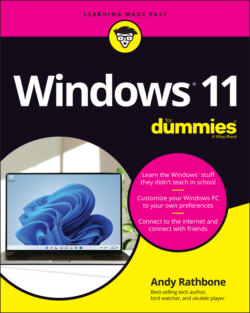Читать книгу Windows 11 For Dummies - Andy Rathbone - Страница 13
SEPARATING THE ADS FROM THE FEATURES
ОглавлениеMicrosoft touts Windows as a helpful companion that always keeps your best interests in mind, but that description isn’t really true. Windows always keeps Microsoft’s interests in mind.
For example, Microsoft uses Windows to plug its own products and services. Microsoft Edge, the new Windows web browser, opens with links to Microsoft’s own websites. The browser’s Favorites area, a place for you to add your favorite web destinations, comes stocked with Microsoft websites.
Windows 11 places a link to OneDrive, its online storage service, in every folder. But Microsoft isn’t as quick to mention that you must pay a recurring fee when you reach your storage limit.
Advertisements appear on the Start menu, as well as the Windows lock screen, the screen that appears when you haven’t used your PC for a while.
The Maps app uses the Microsoft Bing mapping service, rather than Google Maps or another competitor.
Microsoft also wants you to start buying apps rather than traditional programs. Apps are sold only through the bundled Microsoft Store app, and Microsoft takes a cut of each sale.
Simply put, Windows not only controls your computer but also serves as a Microsoft advertising vehicle. Treat these built-in advertising flyers as a salesperson’s knock on your door.
And why are you using Windows 11? Well, you probably didn’t have much choice. Nearly every computer, laptop, or Windows tablet sold after October 2021 comes with Windows 11 preinstalled. A few people escaped Windows by buying Apple computers (those nicer-looking computers that cost a lot more). But chances are good that you, your neighbors, your boss, and millions of other people around the world are using Windows.
Microsoft wants Windows 11 and its gang of apps to run on nearly everything: PCs, laptops, tablets, video game consoles, and even yet-to-be-invented gadgets. That’s why Windows 11 includes many large buttons for easier poking with fingers on touchscreens. Windows 11 can also run apps, small programs usually found on smartphones and tablets, in windows on a desktop PC.
To confuse everybody, Microsoft never released a Windows 9. Microsoft skipped a version number when moving from Windows 8.1 to Windows 10.
To confuse everybody even more, Microsoft said Windows 10 would be the last version of Windows. Six years later, Microsoft began pushing Windows 11.
For years, the desktop’s Start menu lived in your screen’s lower-left corner. Windows 11 moves the Start menu, as well as the Windows key that launches it, to the screen’s bottom center. (I explain how to change it back to its old, lower-left corner home in Chapter 2.)
